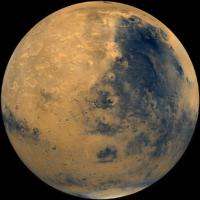Early warning system would predict space storms on Mars

Space weather storms will make living on Mars challenging. The first group of colonists won't need umbrellas; they will need safe houses with 30-foot thick walls made of Martian clay that can withstand radiation storms.
NASA's vision for a permanent human presence on Mars as soon as 2028 will need to address the danger posed by space weather storms. These cyclical winds carrying storms comprised of high-energy particles occur every 11 years, with waves lingering for approximately three years before dying down.
Part of the colonists' survival will depend on an early warning system that can predict these invisible, but deadly storms approaching Mars and signal an "all clear" when the danger passes, says Roger Dube, professor in the Chester F. Carlson Center for Imaging Science at Rochester Institute of Technology.
Dube has won NASA funding to develop a monitoring system that will provide this level of protection for people on Mars. As an additional benefit, the technology will give advanced warning of space storms threatening the critical infrastructure here on Earth, including the power grid, GPS navigation and sensitive communication satellites.
The system Dube envisions includes sensors and small solar observatories at the Mars colony or near the planetary pole for continual view of the solar surface. Special purpose satellites already positioned between the sun and the Earth will require advanced sensors and algorithms to detect signs of a dangerous flux of particles in order to provide warnings to both Earth and Mars.
"The technology we're building uses existing satellites and solar telescopes that are in orbit or in space," says Dube. "Our innovation will be to add artificial intelligence to the recognition of space storms. Initially the technology will be used to calculate the probability of the Earth being hit by a space weather storm, and once we've got that we'll determine the orbital calculations for Mars."
"Mars does not enjoy the defenses against such storms that Earth has," Dube notes.
During a space storm, hurricane-force gusts hit Mars at full force. The winds, containing X-rays and particle rays emitted from solar flares and coronal mass ejections—clumps of high-energy particles belched by the sun—sweep past the planet's weak magnetic field and atmosphere and strike the surface directly.
Even though the Earth's strong magnetic field provides significant protection against these storms, severe storms can momentarily penetrate that defense. Magnetic portals in the Earth's atmosphere have been observed that make our planet susceptible to the effects of severe space weather storms despite its strong magnetic field and atmospheric layers.
"When the wave of particles comes, it can be so intense that it actually bends the Earth's magnetic field way beyond where it naturally belongs to a point where the magnetic field lines nearly cross. When they bend that much, everything snaps and you get this huge deposit of charge at the poles that can go all the way to the equator," Dube says.
The charge is reflected in the ribbons of light known as the aurora borealis and carries the potential for creating havoc on Earth. The same high-energy particles can cripple the power grid by inducing currents into the network and can expose airplane passengers to radiation.
The Space Radiation Analysis Group at Johnson Space Center in Houston, in conjunction with the National Oceanic and Atmospheric Administration, regularly issues alerts to power suppliers and commercial airline carriers within 30 to 60 minutes of a storm. Dube thinks a better monitoring system could provide at least three days advanced warning for people living on Earth and Mars.
"We've got different types of data from different sources, such as images that show the coronal mass ejections," Dube says. "We've got satellites orbiting between the sun and the earth monitoring the particle flux, and we have historical records that take us back in time that tell us what things looked like in the past. We're looking to correlate all of these things together to see if there is a predictor that says, 'Here comes a storm.' "
Dube's team includes imaging science graduate student Santosh Suresh. His work visualizes data downloaded from three radio frequency receivers tuned to the ionosphere, the layer of Earth's atmosphere made up of a molecule-rich plasma charged by solar radiation. The ionosphere observatory at RIT functions as a space weather station and consists of antennae attached to buildings on and around the RIT campus.
Provided by Rochester Institute of Technology

















